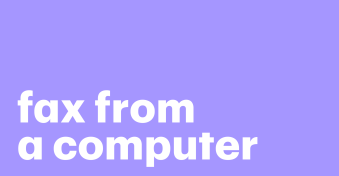Wireless faxing is a handy and cost-effective alternative to traditional faxing methods requiring a physical fax machine and phone line.
But why hasn’t every company transitioned to wireless faxing if it’s so much better than fax machines?
This article explores wireless faxing, how it works, and its benefits over traditional faxing methods. Continue reading to find out the best faxing solution.
What is wireless faxing?
Wireless faxing involves transmitting faxes over the internet via a web application.
This technology has eliminated the need for physical fax machines by letting you send and receive faxes wirelessly.
This form of faxing converts a traditional fax document into a paperless format.
Afterward, it transmits the file using alternative networks to the recipient’s number via a fax service.
This process makes business communication fast, thereby increasing productivity.
How does wireless faxing work?
Wireless faxing works when people or businesses use a fax service connected to the internet.
The service digitizes documents and sends them to the recipient’s number.
The recipient then gets the fax as a digital document which they can print, download, or view.
But can you send fax over WiFi, and do you need a phone line to fax from a wireless printer?
The answer to both questions is yes. But unlike physical fax machines, WiFi transmission is faster, more convenient, and more secure.
How wireless faxing works over WiFi
Wireless faxing tools connect your computer or mobile device to a WiFi network.
Then, these tools convert the document before transferring them to the recipient’s portal.
Once you’ve connected your wireless fax printer to a landline and a WiFi network, you can start sending documents from anywhere.
You can also use your wireless fax machine without a phone line.
Why physical fax machines have to go
Before using a wireless printer fax became available, physical fax machines were the only way to send faxes.
However, these machines had many disadvantages that led to them getting phased out.
For starters, they were very bulky and took up a lot of space in the office.
Additionally, they were expensive to purchase and maintain, requiring a dedicated phone line, paper, ink, and regular maintenance.
Another drawback to using physical machines is that they are limited to a single location; you cannot send or receive faxes remotely.
As a result, users had to be in the same place as the machine to send or receive a file.
This lack of mobility also makes traditional fax machines impractical tools in the modern remote working environment.
Moreover, these devices presented reliability issues and were prone to paper jams and other mechanical problems.
Finally, tracking or storing both sent and received faxes takes time the old-fashioned way, complicating any chance of streamlined organization and record accessibility.
These disadvantages make the shift to wireless faxing a no-brainer for businesses.
The importance of wireless faxing
Wireless faxing offers a solution to the limitations of physical devices: the ability to use it anywhere, untethered to the machine’s physical location.
This flexibility makes it possible to work remotely or on the go, increasing productivity.
WiFi faxing also eliminates the need for bulky, expensive machines and the associated maintenance costs.
A WiFi fax machine is also more reliable than a device that uses a LAN. It is a more secure and stable platform than traditional phone lines.
The online nature of the technology makes tracking and storing sent and received faxes easy, ensuring that valuable information sent over fax is always traceable and recoverable.
Conclusion
Wireless faxing is a modern, convenient, and cost-effective solution to the limitations of physical fax machines.
With wireless faxing, you can send and receive faxes from anywhere, at any time, as long as you have access to the internet.
The benefits of wireless faxing are clear, whether using a wireless fax machine, an online service, or a printer with built-in WiFi fax capabilities.
Tools like Online Fax makes business and personal communication faster.
Companies have begun using them, and you should consider switching too.
Frequently asked questions
-
Yes, you can send a fax over WiFi. You need to connect your device to a wireless network on a router or printer. If you don’t have a machine, you can send wireless faxes using a digital faxing solution.
-
The cost of sending a wireless fax varies depending on your chosen provider and plan. Some providers offer free packages, while others charge a monthly fee for more advanced features. Choose the provider that suits your budget and business needs.
-
Yes, you can fax with a WiFi printer. Some WiFi printers have built-in fax capabilities, allowing you to send and receive faxes directly from the printer without needing a physical fax machine. So, you are basically getting a printer and a fax machine for the price of one.
-
The answer is no. Though you can fax via wireless printer, you still need a landline connection to transmit your documents.
Disclaimer
PandaDoc is not a law firm, or a substitute for an attorney or law firm. This page is not intended to and does not provide legal advice. Should you have legal questions on the validity of e-signatures or digital signatures and the enforceability thereof, please consult with an attorney or law firm. Use of PandaDocs services are governed by our Terms of Use and Privacy Policy.


